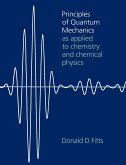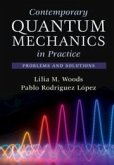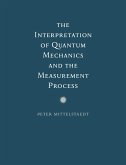Alfred Lande
Principles of Quantum Mechanics
Alfred Lande
Principles of Quantum Mechanics
- Broschiertes Buch
- Merkliste
- Auf die Merkliste
- Bewerten Bewerten
- Teilen
- Produkt teilen
- Produkterinnerung
- Produkterinnerung
Originally published in 1937, this book by renowned physicist Alfred Landé aims 'to develop the principles of quantum mechanics on the basis of a few standard observations'. Landé notes that, in contrast with classical mechanics, quantum mechanics is still a relatively young science with some way to go before it is internally consistent. This book will be of value to anyone with an interest in the history of physics and quantum mechanics.
Andere Kunden interessierten sich auch für
![Principles of Quantum Mechanics Principles of Quantum Mechanics]() Donald D. FittsPrinciples of Quantum Mechanics128,99 €
Donald D. FittsPrinciples of Quantum Mechanics128,99 €![New Foundations of Quantum Mechanics New Foundations of Quantum Mechanics]() Alfred LandeNew Foundations of Quantum Mechanics45,99 €
Alfred LandeNew Foundations of Quantum Mechanics45,99 €![Quantum Mechanics Quantum Mechanics]() Arjun BereraQuantum Mechanics68,99 €
Arjun BereraQuantum Mechanics68,99 €![The Strange World of Quantum Mechanics The Strange World of Quantum Mechanics]() Daniel F. StyerThe Strange World of Quantum Mechanics145,99 €
Daniel F. StyerThe Strange World of Quantum Mechanics145,99 €![Contemporary Quantum Mechanics in Practice Contemporary Quantum Mechanics in Practice]() Lilia M WoodsContemporary Quantum Mechanics in Practice81,99 €
Lilia M WoodsContemporary Quantum Mechanics in Practice81,99 €![The Interpretation of Quantum Mechanics and the Measurement Process The Interpretation of Quantum Mechanics and the Measurement Process]() Peter MittelstaedtThe Interpretation of Quantum Mechanics and the Measurement Process53,99 €
Peter MittelstaedtThe Interpretation of Quantum Mechanics and the Measurement Process53,99 €![A Philosopher's Understanding of Quantum Mechanics A Philosopher's Understanding of Quantum Mechanics]() Pieter E. VermaasA Philosopher's Understanding of Quantum Mechanics145,99 €
Pieter E. VermaasA Philosopher's Understanding of Quantum Mechanics145,99 €-
-
-
Originally published in 1937, this book by renowned physicist Alfred Landé aims 'to develop the principles of quantum mechanics on the basis of a few standard observations'. Landé notes that, in contrast with classical mechanics, quantum mechanics is still a relatively young science with some way to go before it is internally consistent. This book will be of value to anyone with an interest in the history of physics and quantum mechanics.
Produktdetails
- Produktdetails
- Verlag: Cambridge University Press
- Seitenzahl: 132
- Erscheinungstermin: 15. August 2013
- Englisch
- Abmessung: 216mm x 140mm x 7mm
- Gewicht: 177g
- ISBN-13: 9781107667839
- ISBN-10: 1107667836
- Artikelnr.: 39602485
- Herstellerkennzeichnung
- Libri GmbH
- Europaallee 1
- 36244 Bad Hersfeld
- gpsr@libri.de
- Verlag: Cambridge University Press
- Seitenzahl: 132
- Erscheinungstermin: 15. August 2013
- Englisch
- Abmessung: 216mm x 140mm x 7mm
- Gewicht: 177g
- ISBN-13: 9781107667839
- ISBN-10: 1107667836
- Artikelnr.: 39602485
- Herstellerkennzeichnung
- Libri GmbH
- Europaallee 1
- 36244 Bad Hersfeld
- gpsr@libri.de
Preface; Introduction: 1. Observation and interpretation; 2. Difficulties of the classical theories; 3. The purpose of quantum theory; Part I. Elementary Theory of Observation (Principle of Complementarity): 4. Refraction in inhomogeneous media (force fields); 5. Scattering of charged rays; 6. Refraction and reflection at a plane; 7. Absolute values of momentum and wave length; 8. Double ray of matter diffracting light waves; 9. Double ray of matter diffracting photons; 10. Microscopic observation of
(x) and
(p); 11. Complementarity; 12. Mathematical relation between
(x) and
(p) for free particles; 13. General relation between
(q) and
(p); 14. Crystals; 15. Transition density and transition probability; 16. Resultant values of physical functions; matrix elements; 17. Pulsating density; 18. General relation between
(t) and
(
); 19. Transition density; matrix elements; Part II. The Principle of Uncertainty: 20. Optical observation of density in matter packets; 21. Distribution of momenta in matter packets; 22. Mathematical relation between
and
; 23. Causality; 24. Uncertainty; 25. Uncertainty due to optical observation; 26. Dissipation of matter packets; rays in Wilson Chamber; 27. Density maximum in time; 28. Uncertainty of energy and time; 29. Compton effect; 30. Bothe-Geiger and Compton-Simon experiments; 31. Doppler effect; Raman effect; 32. Elementary bundles of rays; 33. Jeans' number of degrees of freedom; 34. Uncertainty of electromagnetic field components; Part III. The Principle of Interference and Schrödinger's equation: 35. Physical functions; 36. Interference of probabilities for p and q; 37. General interference of probabilities; 38. Differential equations for
p (q) and Xq (p); 39. Differential equation for
ß (q); 40. The general probability amplitude
ß' (Q); 41. Point transformations; 42. General theorem of interference; 43. Conjugate variables; 44. Schrödinger's equation for conservative systems; 45. Schrödinger's equation for non-conservative systems; 46. Pertubation theory; 47. Orthogonality, normalization and Hermitian conjugacy; 48. General matrix elements; Part IV. The Principle of Correspondence: 49. Contact transformations in classical mechanics; 50. Point transformations; 51. Contact transformations in quantum mechanics; 52. Constants of motion and angular co-ordinates; 53. Periodic orbits; 54. De Broglie and Schrödinger function; correspondence to classical mechanics; 55. Packets of probability; 56. Correspondence to hydrodynamics; 57. Motion and scattering of wave packets; 58. Formal correspondence between classical and quantum mechanics; Part V. Mathematical Appendix: Principle of Invariance: 59. The general theorem of transformation; 60. Operator calculus; 61. Exchange relations; three criteria for conjugacy; 62. First method of canonical transformation; 63. Second method of canonical transformation; 64. Proof of the transformation theorem; 65. Invariance of the matrix elements against unitary transformations; 66. Matrix mechanics; Index of literature; Index of names and subjects.
(x) and
(p); 11. Complementarity; 12. Mathematical relation between
(x) and
(p) for free particles; 13. General relation between
(q) and
(p); 14. Crystals; 15. Transition density and transition probability; 16. Resultant values of physical functions; matrix elements; 17. Pulsating density; 18. General relation between
(t) and
(
); 19. Transition density; matrix elements; Part II. The Principle of Uncertainty: 20. Optical observation of density in matter packets; 21. Distribution of momenta in matter packets; 22. Mathematical relation between
and
; 23. Causality; 24. Uncertainty; 25. Uncertainty due to optical observation; 26. Dissipation of matter packets; rays in Wilson Chamber; 27. Density maximum in time; 28. Uncertainty of energy and time; 29. Compton effect; 30. Bothe-Geiger and Compton-Simon experiments; 31. Doppler effect; Raman effect; 32. Elementary bundles of rays; 33. Jeans' number of degrees of freedom; 34. Uncertainty of electromagnetic field components; Part III. The Principle of Interference and Schrödinger's equation: 35. Physical functions; 36. Interference of probabilities for p and q; 37. General interference of probabilities; 38. Differential equations for
p (q) and Xq (p); 39. Differential equation for
ß (q); 40. The general probability amplitude
ß' (Q); 41. Point transformations; 42. General theorem of interference; 43. Conjugate variables; 44. Schrödinger's equation for conservative systems; 45. Schrödinger's equation for non-conservative systems; 46. Pertubation theory; 47. Orthogonality, normalization and Hermitian conjugacy; 48. General matrix elements; Part IV. The Principle of Correspondence: 49. Contact transformations in classical mechanics; 50. Point transformations; 51. Contact transformations in quantum mechanics; 52. Constants of motion and angular co-ordinates; 53. Periodic orbits; 54. De Broglie and Schrödinger function; correspondence to classical mechanics; 55. Packets of probability; 56. Correspondence to hydrodynamics; 57. Motion and scattering of wave packets; 58. Formal correspondence between classical and quantum mechanics; Part V. Mathematical Appendix: Principle of Invariance: 59. The general theorem of transformation; 60. Operator calculus; 61. Exchange relations; three criteria for conjugacy; 62. First method of canonical transformation; 63. Second method of canonical transformation; 64. Proof of the transformation theorem; 65. Invariance of the matrix elements against unitary transformations; 66. Matrix mechanics; Index of literature; Index of names and subjects.
Preface; Introduction: 1. Observation and interpretation; 2. Difficulties of the classical theories; 3. The purpose of quantum theory; Part I. Elementary Theory of Observation (Principle of Complementarity): 4. Refraction in inhomogeneous media (force fields); 5. Scattering of charged rays; 6. Refraction and reflection at a plane; 7. Absolute values of momentum and wave length; 8. Double ray of matter diffracting light waves; 9. Double ray of matter diffracting photons; 10. Microscopic observation of
(x) and
(p); 11. Complementarity; 12. Mathematical relation between
(x) and
(p) for free particles; 13. General relation between
(q) and
(p); 14. Crystals; 15. Transition density and transition probability; 16. Resultant values of physical functions; matrix elements; 17. Pulsating density; 18. General relation between
(t) and
(
); 19. Transition density; matrix elements; Part II. The Principle of Uncertainty: 20. Optical observation of density in matter packets; 21. Distribution of momenta in matter packets; 22. Mathematical relation between
and
; 23. Causality; 24. Uncertainty; 25. Uncertainty due to optical observation; 26. Dissipation of matter packets; rays in Wilson Chamber; 27. Density maximum in time; 28. Uncertainty of energy and time; 29. Compton effect; 30. Bothe-Geiger and Compton-Simon experiments; 31. Doppler effect; Raman effect; 32. Elementary bundles of rays; 33. Jeans' number of degrees of freedom; 34. Uncertainty of electromagnetic field components; Part III. The Principle of Interference and Schrödinger's equation: 35. Physical functions; 36. Interference of probabilities for p and q; 37. General interference of probabilities; 38. Differential equations for
p (q) and Xq (p); 39. Differential equation for
ß (q); 40. The general probability amplitude
ß' (Q); 41. Point transformations; 42. General theorem of interference; 43. Conjugate variables; 44. Schrödinger's equation for conservative systems; 45. Schrödinger's equation for non-conservative systems; 46. Pertubation theory; 47. Orthogonality, normalization and Hermitian conjugacy; 48. General matrix elements; Part IV. The Principle of Correspondence: 49. Contact transformations in classical mechanics; 50. Point transformations; 51. Contact transformations in quantum mechanics; 52. Constants of motion and angular co-ordinates; 53. Periodic orbits; 54. De Broglie and Schrödinger function; correspondence to classical mechanics; 55. Packets of probability; 56. Correspondence to hydrodynamics; 57. Motion and scattering of wave packets; 58. Formal correspondence between classical and quantum mechanics; Part V. Mathematical Appendix: Principle of Invariance: 59. The general theorem of transformation; 60. Operator calculus; 61. Exchange relations; three criteria for conjugacy; 62. First method of canonical transformation; 63. Second method of canonical transformation; 64. Proof of the transformation theorem; 65. Invariance of the matrix elements against unitary transformations; 66. Matrix mechanics; Index of literature; Index of names and subjects.
(x) and
(p); 11. Complementarity; 12. Mathematical relation between
(x) and
(p) for free particles; 13. General relation between
(q) and
(p); 14. Crystals; 15. Transition density and transition probability; 16. Resultant values of physical functions; matrix elements; 17. Pulsating density; 18. General relation between
(t) and
(
); 19. Transition density; matrix elements; Part II. The Principle of Uncertainty: 20. Optical observation of density in matter packets; 21. Distribution of momenta in matter packets; 22. Mathematical relation between
and
; 23. Causality; 24. Uncertainty; 25. Uncertainty due to optical observation; 26. Dissipation of matter packets; rays in Wilson Chamber; 27. Density maximum in time; 28. Uncertainty of energy and time; 29. Compton effect; 30. Bothe-Geiger and Compton-Simon experiments; 31. Doppler effect; Raman effect; 32. Elementary bundles of rays; 33. Jeans' number of degrees of freedom; 34. Uncertainty of electromagnetic field components; Part III. The Principle of Interference and Schrödinger's equation: 35. Physical functions; 36. Interference of probabilities for p and q; 37. General interference of probabilities; 38. Differential equations for
p (q) and Xq (p); 39. Differential equation for
ß (q); 40. The general probability amplitude
ß' (Q); 41. Point transformations; 42. General theorem of interference; 43. Conjugate variables; 44. Schrödinger's equation for conservative systems; 45. Schrödinger's equation for non-conservative systems; 46. Pertubation theory; 47. Orthogonality, normalization and Hermitian conjugacy; 48. General matrix elements; Part IV. The Principle of Correspondence: 49. Contact transformations in classical mechanics; 50. Point transformations; 51. Contact transformations in quantum mechanics; 52. Constants of motion and angular co-ordinates; 53. Periodic orbits; 54. De Broglie and Schrödinger function; correspondence to classical mechanics; 55. Packets of probability; 56. Correspondence to hydrodynamics; 57. Motion and scattering of wave packets; 58. Formal correspondence between classical and quantum mechanics; Part V. Mathematical Appendix: Principle of Invariance: 59. The general theorem of transformation; 60. Operator calculus; 61. Exchange relations; three criteria for conjugacy; 62. First method of canonical transformation; 63. Second method of canonical transformation; 64. Proof of the transformation theorem; 65. Invariance of the matrix elements against unitary transformations; 66. Matrix mechanics; Index of literature; Index of names and subjects.









